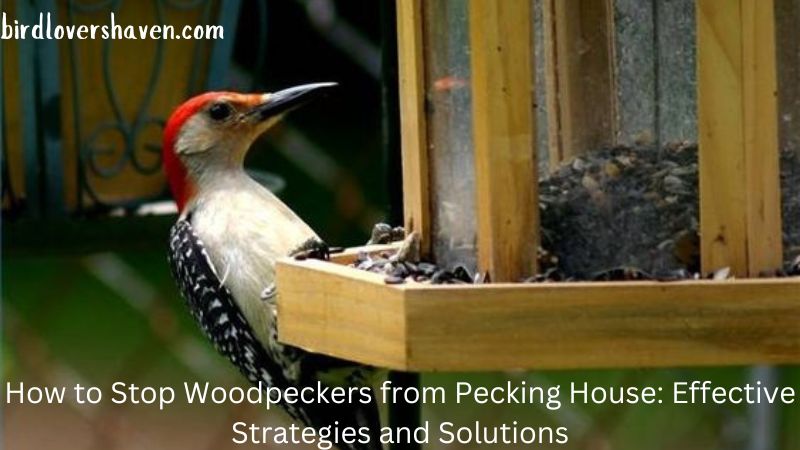Birds and Bird Behavior
How to Stop Woodpeckers from Pecking House: Effective Strategies and Solutions
How to Stop Woodpeckers from Pecking House? Woodpeckers are fascinating birds known for their distinctive pecking behavior, which they use to find food, create nesting sites, and communicate with other woodpeckers. However, this behavior can become a nuisance when they target homes and other structures, causing damage to siding, eaves, and other wooden parts of the building.
Homeowners dealing with this issue often find themselves frustrated, searching for effective ways to stop woodpeckers from pecking their houses. This article birdlovershaven.com explores the reasons why woodpeckers peck on houses, the types of damage they can cause, and a variety of strategies to deter them humanely and effectively.
Understanding Why Woodpeckers Peck on Houses
Reasons for Pecking
Woodpeckers peck on houses for several reasons, and understanding these motivations is key to finding the right solution:
- Foraging for Food: Woodpeckers primarily feed on insects, especially wood-boring beetles and larvae. If your house has an infestation of insects like carpenter ants, termites, or other wood-dwelling bugs, woodpeckers may be attracted to the noise and vibrations these insects create within the walls. The birds peck at the wood to access these insects for food.
- Creating Nesting Sites: During the breeding season, woodpeckers create cavities in dead trees or wooden structures to lay their eggs. If they perceive your home’s wooden siding or eaves as suitable nesting sites, they may start drilling holes to build a nest.
- Drumming to Mark Territory: Woodpeckers also engage in a behavior known as drumming, where they peck rapidly on resonant surfaces to create a loud sound. This drumming is not an attempt to damage the wood but rather a way to communicate with other woodpeckers, either to attract a mate or to mark territory. Homes with metal gutters, chimney caps, or wooden siding can amplify the sound, making them attractive to drumming woodpeckers.
- Storing Food: Some species of woodpeckers, like the Acorn Woodpecker, are known to store food by pecking holes in wood and inserting acorns or other items. While less common, this behavior can lead to repeated damage if your house is used as a storage site.
Identifying the Problem
Before implementing any control measures, it’s important to identify the specific reason why woodpeckers are targeting your home. Observing the birds’ behavior and the locations where they are pecking can provide clues. For instance, if they are pecking near the roofline or in areas with existing insect damage, they may be foraging for food. If the pecking is concentrated in one spot and the holes are deep, they might be trying to build a nest. Recognizing these patterns will help you choose the most effective deterrent strategies.
The Damage Caused by Woodpeckers
Types of Damage
Woodpecker activity can lead to several types of damage to your home, which can range from minor to severe:
- Cosmetic Damage: Small holes and surface scratches from drumming can mar the appearance of your siding, trim, or other wooden surfaces. While this damage may not compromise the structural integrity of your home, it can be unsightly and require repair.
- Structural Damage: If woodpeckers are pecking to create nesting cavities or to access insects, they can create larger holes that penetrate deep into the wood. Over time, this can weaken the structure, especially if the damage goes unnoticed or untreated.
- Secondary Damage from Pests: The holes created by woodpeckers can provide entry points for other pests, such as insects, rodents, or water. This can lead to further damage, including mold growth, wood rot, or infestations that exacerbate the initial problem.
- Noise Disturbance: The drumming behavior of woodpeckers can be loud and persistent, especially in the early morning hours. This noise can be disruptive to your household, affecting sleep and overall comfort.
Assessing the Extent of Damage
It’s important to regularly inspect your home for signs of woodpecker activity, especially if you live in an area where these birds are common. Look for small holes, chips, or larger cavities in wooden structures, and check for signs of insect infestation that might be attracting the birds. If you notice any damage, addressing it promptly can prevent it from worsening and becoming more costly to repair.
Effective Strategies to Deter Woodpeckers
Visual Deterrents
Visual deterrents are often the first line of defense against woodpeckers. These methods work by making the area less attractive or more intimidating to the birds:
- Reflective Objects: Hanging reflective materials like aluminum foil strips, old CDs, or mirrors near the areas where woodpeckers are pecking can help deter them. The movement and glare created by these objects can scare the birds away, as they associate the reflections with potential danger.
- Decoy Predators: Placing decoys of predatory birds, such as owls or hawks, near the affected areas can also be effective. These decoys should be moved regularly to maintain their effectiveness, as woodpeckers can become accustomed to stationary objects.
- Brightly Colored Tape or Streamers: Similar to reflective objects, brightly colored tape or streamers can create movement and visual disruption that deters woodpeckers. These should be placed near the areas where the birds are most active.
Auditory Deterrents
Auditory deterrents use sound to scare away woodpeckers. These methods are often combined with visual deterrents for greater effectiveness:
- Noise Devices: Devices that emit loud noises, such as ultrasonic repellers or devices that mimic predator calls, can help scare woodpeckers away. However, these devices should be used with caution, as they can also disturb pets and other wildlife.
- Wind Chimes or Bells: Installing wind chimes or bells near the affected areas can create constant noise that deters woodpeckers. The irregularity of the sounds, combined with the movement of the chimes, can make the area less appealing to the birds.
Physical Barriers

Installing physical barriers can be a highly effective way to prevent woodpeckers from accessing your home:
- Netting: Bird netting can be draped over the areas where woodpeckers are active. This creates a physical barrier that prevents the birds from reaching the wood. Make sure the netting is installed securely and is tight enough that the birds cannot get trapped underneath.
- Metal or Plastic Sheeting: Installing metal or plastic sheeting over the affected areas can protect the wood from further damage. These materials are too hard for woodpeckers to penetrate, and they can also make drumming less satisfying for the birds.
- Stucco or Vinyl Siding: If woodpecker damage is a persistent issue, consider replacing wooden siding with materials that are less appealing to the birds, such as stucco or vinyl. These materials are not suitable for pecking or nesting, making them a more permanent solution.
Habitat Modification
Making changes to your home’s environment can reduce its attractiveness to woodpeckers:
- Remove Food Sources: If woodpeckers are attracted to your home because of an insect infestation, addressing the underlying issue is crucial. Consider hiring a pest control professional to eliminate the insects and repair any damage caused by them. Without a food source, woodpeckers are less likely to return.
- Limit Nesting Opportunities: Regularly inspect your home for potential nesting sites and seal any holes or gaps that could be used by woodpeckers. Prune nearby trees and shrubs to reduce access to your home’s exterior and remove any dead trees that could serve as alternative nesting sites.
- Maintain Your Property: Regular maintenance, such as painting or staining wooden surfaces, can make your home less appealing to woodpeckers. Fresh paint or stain can cover existing damage and create a smoother surface that is harder for woodpeckers to grip.
Humane Exclusion Techniques
If woodpeckers have already begun nesting in your home, humane exclusion is necessary:
- Timing the Exclusion: It’s important to ensure that no eggs or chicks are in the nest before taking action. The best time to exclude woodpeckers is before the nesting season begins, usually in early spring. If a nest is already active, it’s best to wait until the young have fledged before closing off access.
- Sealing Entry Points: Once you’re sure the nest is no longer in use, seal off the entry points with durable materials such as wood, metal flashing, or caulk. This will prevent woodpeckers from returning to the same spot next season.
- Providing Alternative Nesting Sites: Installing a woodpecker house or nesting box nearby can offer the birds an alternative nesting site. Place the box on a tree or post at least 15-20 feet above the ground, away from your home. This can satisfy their nesting needs while protecting your house from further damage.





